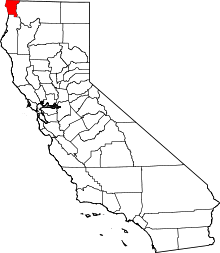Smith River Reservation
Smith River Reservation was a reservation of land on the Smith River, set aside April 9, 1862 by the Department of Indian Affairs to replace the Klamath River Reservation that had been destroyed by the Great Flood of 1862 and as a reservation for the Tolowa people.[1]:312
Camp Lincoln was to be built nearby to replace Fort Ter-Waw that had also been severely damaged in the flood. Camp Lincoln was built to protect the American citizens in the vicinity of Crescent City from the native people. However its location was moved on September 11, 1862, by Major James F. Curtis to a location six miles north of the city in a clearing in a forest of redwoods near the reservation. This done so as to be more effective in protecting the reservation Indians from the citizens.
In September 1862, over 800 of the native people captured in the Bald Hills War were sent to the Reservation. The garrison was given the additional task of preventing them from escaping and returning to the Bald Hills and Eel River country. However they were not very successful in that task, hundreds of these native people escaped that fall.[2]
The Smith River Reservation was discontinued by act of Congress in July 28,1868.[1]:312
See also
- Klamath River Reservation
- Mendocino Indian Reservation
- Nome Cult Farm
- Nome Lackee Reservation
- Sebastian Indian Reservation
- Tule River Farm
- Fresno Indian Farm
- Kings River Indian Farm
